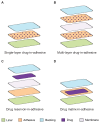Transdermal donepezil on the treatment of Alzheimer's disease
- PMID: 22942647
- PMCID: PMC3428243
- DOI: 10.2147/NDT.S16089
Transdermal donepezil on the treatment of Alzheimer's disease
Abstract
Alzheimer's disease (AD) is the most common type of senile dementia, characterized by cognitive deficits related to degeneration of cholinergic neurons. The first anti-Alzheimer drugs approved by the Food and Drug Administration were the cholinesterase inhibitors (ChEIs), which are capable of improving cholinergic neurotransmission by inhibiting acetylcholinesterase. The most common ChEIs used to treat cognitive symptoms in mild to moderate AD are rivastigmine, galantamine, and donepezil. In particular, the lattermost drug has been widely used to treat AD patients worldwide because it is significantly less hepatotoxic and better tolerated than its predecessor, tetrahydroaminoacridine. It also demonstrates high selectivity towards acetylcholinesterase inhibition and has a long duration of action. The formulations available for donepezil are immediate release (5 or 10 mg), sustained release (23 mg), and orally disintegrating (5 or 10 mg) tablets, all of which are intended for oral-route administration. Since the oral donepezil therapy is associated with adverse events in the gastrointestinal system and in plasma fluctuations, an alternative route of administration, such as the transdermal one, has been recently attempted. The goal of this paper is to provide a critical overview of AD therapy with donepezil, focusing particularly on the advantages of the transdermal over the oral route of administration.
Keywords: Alzheimer’s disease; donepezil; patch; transdermal.
Figures
Similar articles
-
Cholinesterase Inhibitors for Alzheimer's Disease: Multitargeting Strategy Based on Anti-Alzheimer's Drugs Repositioning.Curr Pharm Des. 2019;25(33):3519-3535. doi: 10.2174/1381612825666191008103141. Curr Pharm Des. 2019. PMID: 31593530 Review.
-
An update on the safety of current therapies for Alzheimer's disease: focus on rivastigmine.Ther Adv Drug Saf. 2018 Mar;9(3):171-178. doi: 10.1177/2042098617750555. Epub 2018 Jan 8. Ther Adv Drug Saf. 2018. PMID: 29492246 Free PMC article. Review.
-
Guidelines for pharmacotherapy in Alzheimer's disease - A primer on FDA-approved drugs.J Neurosci Rural Pract. 2023 Oct-Dec;14(4):566-573. doi: 10.25259/JNRP_356_2023. Epub 2023 Oct 7. J Neurosci Rural Pract. 2023. PMID: 38059250 Free PMC article. Review.
-
The tolerability and safety of cholinesterase inhibitors in the treatment of dementia.Int J Clin Pract Suppl. 2002 Jun;(127):45-63. Int J Clin Pract Suppl. 2002. PMID: 12139367 Review.
-
The donepezil transdermal system for the treatment of patients with mild, moderate, or severe Alzheimer's disease: a critical review.Expert Rev Neurother. 2024 Jun;24(6):607-614. doi: 10.1080/14737175.2024.2355981. Epub 2024 May 24. Expert Rev Neurother. 2024. PMID: 38785454 Review.
Cited by
-
Comparison of Steady-State Pharmacokinetics of Donepezil Transdermal Delivery System with Oral Donepezil.J Alzheimers Dis. 2022;90(1):161-172. doi: 10.3233/JAD-220530. J Alzheimers Dis. 2022. PMID: 36120781 Free PMC article. Clinical Trial.
-
Preparation, Characterization, and In Vivo Pharmacokinetic Evaluation of Polyvinyl Alcohol and Polyvinyl Pyrrolidone Blended Hydrogels for Transdermal Delivery of Donepezil HCl.Pharmaceutics. 2020 Mar 16;12(3):270. doi: 10.3390/pharmaceutics12030270. Pharmaceutics. 2020. PMID: 32188083 Free PMC article.
-
Donepezil Brain and Blood Pharmacokinetic Modeling after Nasal Film and Oral Solution Administration in Mice.Pharmaceutics. 2023 May 5;15(5):1409. doi: 10.3390/pharmaceutics15051409. Pharmaceutics. 2023. PMID: 37242651 Free PMC article.
-
Fabrication of Hybrid Coated Microneedles with Donepezil Utilizing Digital Light Processing and Semisolid Extrusion Printing for the Management of Alzheimer's Disease.Mol Pharm. 2024 Sep 2;21(9):4450-4464. doi: 10.1021/acs.molpharmaceut.4c00377. Epub 2024 Aug 20. Mol Pharm. 2024. PMID: 39163171 Free PMC article.
-
Single dose pharmacokinetics of the novel transdermal donepezil patch in healthy volunteers.Drug Des Devel Ther. 2015 Mar 10;9:1419-26. doi: 10.2147/DDDT.S78555. eCollection 2015. Drug Des Devel Ther. 2015. PMID: 25792802 Free PMC article. Clinical Trial.
References
-
- Small GW, Rabins PV, Barry PP, et al. Diagnosis and treatment of Alzheimer disease and related disorders. Consensus statement of the American Association for Geriatric Psychiatry, the Alzheimer’s Association, and the American Geriatrics Society. JAMA. 1997;278(16):1363–1371. - PubMed
-
- Bryne GJ. Treatment of cognitive impairment in Alzheimer’s disease. Australian Journal of Hospital Pharmacy. 1998;28:261–266.
-
- Dooley M, Lamb HM. Donepezil: a review of its use in Alzheimer’s disease. Drugs Aging. 2000;16(3):199–226. - PubMed
-
- Chan AL, Chien YW, Jin Lin S. Transdermal delivery of treatment for Alzheimer’s disease: development, clinical performance and future prospects. Drugs Aging. 2008;25(9):761–775. - PubMed
-
- Cutler NR, Sramek JJ. The role of bridging studies in the development of cholinesterase inhibitors for Alzheimer’s disease. CNS Drugs. 1998;10(5):355–364.
LinkOut - more resources
Full Text Sources
Other Literature Sources
Molecular Biology Databases



